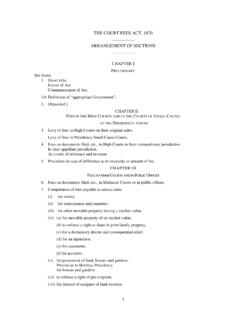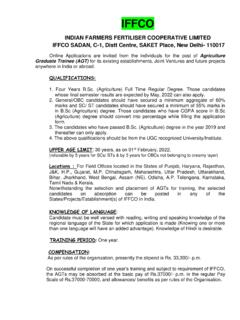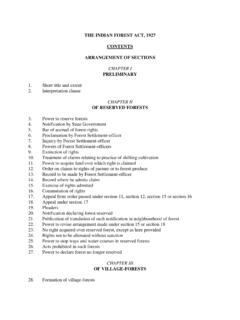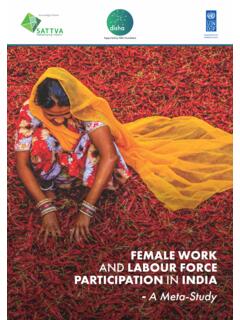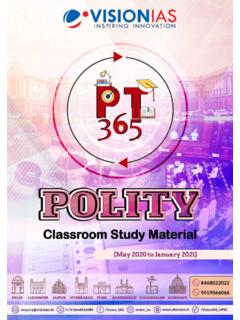Transcription of CHILD LABOUR IN INDIA - International Labour Organization
1 The term CHILD LABOUR 1 is often defined as work that deprives children of their childhood, their potential and their dignity, and that is harmful to physical and mental development. It refers to work that: - is mentally, physically, socially or morally dangerous and harmful to children; and/or - interferes with a CHILD s ability to attend and participate in school fully by obliging them to leave school prematurely; or requiring them to attempt to combine school attendance with excessively long and heavy work. There are many inter-linked factors contributing to the prevalence of CHILD LABOUR . CHILD LABOUR is both a cause and consequence of poverty. Household poverty forces children into the LABOUR market to earn money. Some perform CHILD LABOUR to supplement family income while many also are in it for survival. They miss out on an opportunity to gain an education, further perpetuating household poverty across generations, slowing the economic growth and social development.
2 CHILD LABOUR impedes children from gaining the skills and education they need to have opportunities of decent work as an adult. Inequality, lack of educational opportunities, slow demographic transition, traditions and cultural expectations all contribute to the persistence of CHILD LABOUR in INDIA . Age, sex, ethnicity, caste and deprivation affect the type and intensity of work that children perform. Agriculture and informal sector employment continue to be sectors where children end up working. The ILO experience is that stable economic growth, respect for LABOUR standards, decent work, universal education, social protection, recognizing the needs and rights of the children together help tackle the root causes of CHILD LABOUR . 1 The term CHILD LABOUR and working children have different connotations, but both the terms are used interchangeably on account of limitations of the available datasets. CHILD LABOUR IN INDIA ILO As per Census 2011, the total CHILD population in INDIA in the age group (5-14) years is million.
3 Of these, million ( of total CHILD population) are working, either as main worker or as marginal worker . In addition, more than million children in INDIA are out of school. However, the good news is that the incidence of CHILD LABOUR has decreased in INDIA by million between 2001 and 2011. However, the decline was more visible in rural areas, while the number of CHILD workers has increased in urban areas, indicating the growing demand for CHILD workers in menial jobs. CHILD LABOUR has different ramifications in both rural and urban INDIA . Year Percentage of working children (5-14) Total number of working children (5-14) (in millions) Rural Urban Total Rural Urban Total 2001 2011 *Source Census 2001 and 2011 Distribution of working children by type of work in 2011 Area of work Percentage Numbers (in millions) Cultivators Agricultural labourers Household industry workers Other workers *Source Census 2011 Note: Other workers : Workers other than cultivators, agricultural labourers or workers in household industries sectors for working children in INDIA (%)CultivatorsAgricultural labourersHHI workersOther workers Together, Uttar Pradesh, bihar , Rajasthan, Maharashtra, and Madhya Pradesh constitute nearly 55% of total working children in INDIA .
4 States Percentage Numbers (In million) Uttar Pradesh bihar Rajasthan Maharashtra Madhya Pradesh *Source Census 2011 The enactment of the CHILD LABOUR Amendment (Prohibition and Regulation) Act, 2016 and The Right to Education Act 2009 have paved the way for ratification of ILO s two core conventions 1. Convention No 138 stipulates that the minimum age at which children can start work should not be below the age of compulsory schooling and in any case not less than 15 years; with a possible exception for developing countries. 2. Convention No. 182 prohibits hazardous work which is likely to jeopardize children s physical, mental or moral health. It aims at immediate elimination of the worst forms of CHILD LABOUR for children below 18 years. - The global figure of CHILD labourers stands at 168 million (2012). - Asia and the Pacific still has the largest numbers of CHILD labourers (almost 78 million or of CHILD population), but Sub-Saharan Africa continues to be the region with the highest incidence of CHILD LABOUR (59 million, over 21%).
5 - Globally, agriculture remains by far the most prominent sector where CHILD labourers can be found (98 million), but the problems are not negligible in services (54 million) and industry (12 million). This is found to be the case mostly in the informal economy. For further information please contact ILO Decent Work Team for South Asia and Country Office for INDIA , Core 4B, Third Floor, INDIA Habitat Centre, New Delhi 110003, INDIA ; ILO












